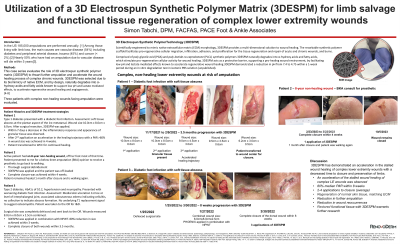Case Series/Study
(CS-146) Utilization of a 3D Electrospun Synthetic Polymer Matrix (3DESPM) for limb salvage and functional tissue regeneration of complex lower extremity wounds

In the US 185,000 amputations are performed annually. [1] Among those living with limb loss, the main causes are vascular disease (54%) including diabetes and peripheral arterial disease, trauma (45%) and cancer (< 2%).[2] Nearly 50% who have had an amputation due to vascular disease will die within 5 years[3].
Methods:
This case series evaluates the role of a 3D electrospun synthetic polymer matrix (3DESPM) to accelerate the stalled wound healing process of complex chronic wounds. 3DESPM was selected due to its biomimicry of native ECM, and by design, naturally biodegrades into α-hydroxy acids and fatty acids known to support low pH and aid in regenerative wound healing. [4-8]
Three patients with complex non-healing wounds facing amputation were evaluated. 3DESPM was selected to address the chronic nature of the tissue and provide a biomimetic synthetic scaffold to accelerate the regeneration of functional tissue.
Results:
Patient 1
Patient with type 1 diabetes presented with a diabetic foot infection.
Assessment: soft tissue abscess at the plantar aspect of the 1st metatarsal. Wound size 10.0cmx8.0cmx6.0cm
After surgical resection, 3DESPM was applied. Within 7 days a decrease in the inflammatory response with appearance of granular tissue was observed. Greater than 60% reduction in wound size was achieved in 4 weeks. Patient transitioned to WCC for continued healing.
Patient 2
Patient with type 2 diabetes, HbA1c of 10.2, hypertension and neuropathy. Presented with worsening diabetic foot infection.
Assessment: Medial skin ulceration 1st toe at level of interphalangeal joint, associated subcutaneous edema indicating cellulitis, no collection to indicate abscess formation. No underlying T1 replacement signal to suggest osteomyelitis. Patient was taken to the OR for I&D.
Surgical site was completely dehisced and sent back to the OR. Wounds measured 8.0cmx8.0cmx2.5cm combined.
3DESPM was applied in combination with NPWT.
80% reduction in size achieved within 3 weeks.
Complete closure of both wounds within 3.5 months.
Patient 3
Patient had a non-healing wound for 8 years, off her foot most of that time. Patient presented to me for a below-knee amputation (BKA) opinion, receive a prosthetic and go back to walking.
After thorough surgical debridement, 3DESPM was applied and the patient was off-loaded.
Complete closure was achieved within 4 weeks.
Patient remained healed 1 month after closure and is walking again.
Discussion:
3DESPM has demonstrated an acceleration in the stalled wound healing of complex lower extremity wounds with a decreased time to closure and preservation of limbs.
Trademarked Items: PHOENIX Wound Matrix
References: 1. Ziegler‐Graham K, MacKenzie EJ, Ephraim PL, Travison TG, Brookmeyer R. Estimating the Prevalence of Limb Loss in the United States: 2005 to 2050. Archives of Physical Medicine and Rehabilitation2008;89(3):422‐9
2. Owings M, Kozak LJ, National Center for Health S. Ambulatory and Inpatient Procedures in the United States, 1996. Hyattsville, Md.: U.S. Dept. of Health and Human Services, Centers for Disease Control and Prevention, National Center for Health Statistics; 1998
3. Robbins JM, Strauss G, Aron D, Long J, Kuba J, Kaplan Y. Mortality Rates and Diabetic Foot Ulcers. Journal of the American Podiatric Medical Association2008 November 1, 2008;98(6):489‐93
4. Jones, E.M., C.A. Cochrane, and S.L. Percival, The Effect of pH on the Extracellular Matrix and Biofilms. Adv Wound Care (New Rochelle), 2015. 4(7): p. 431-439.
5. Gethin, G., The significance of surface pH in chronic wounds. Wounds UK, 2007. 3.
6. B, G., et al., Proteases and pH in chronic wounds. Journal of Wound Care, 2005. 14(2): p. 59-61.;
7. TK, H. and B. S, Theoretical and Practical Aspects of Oxygen in Wound Healing, in The Wound Management Manual, L. B, Editor. 2005, McGraw-Hill: New York. p. 44-54.
8. Leveen, H.H., et al., Chemical acidification of wounds. An adjuvant to healing and the unfavorable action of alkalinity and ammonia. Annals of surgery, 1973. 178(6): p. 745-753

.png)